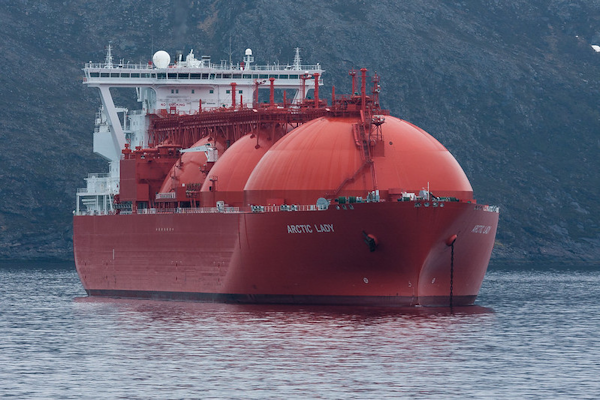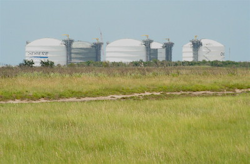SEJournal Online is the digital news magazine of the Society of Environmental Journalists. Learn more about SEJournal Online, including submission, subscription and advertising information.
 |
 |
| Some worry the explosion and fire from a punctured LNG tanker would be devastating, but the industry points to a good safety record. Above, a Norwegian LNG tanker in 2013. Photo: Amanda Graham via Flickr Creative Commons (CC BY-NC-ND 2.0 DEED). |
Issue Backgrounder: LNG To Fuel Conflict, Profit, Warming in Coming Years
By Joseph A. Davis
Liquified natural gas will fuel major news on the environment beat in years to come. It has already been doing so. The tricky thing for journalists is cutting through the fog of arguments about it.
LNG is currently in the news because the oil and gas industry is unhappy about President Biden’s “pause” on LNG export permit approvals, announced Jan. 26. The American Petroleum Institute has signaled it will challenge the decision in court. Other gas industry groups are lining up to join the opposition.
The stakes are huge: climate heating, weaning European Union allies off of Russian gas, sanctioning Russia, raising of domestic natural gas prices, the November 2024 election — oh, yes, and tens of billions in profits for the oil companies.
A House bill is unlikely to
pass the Senate or to be signed
by Biden. What it does accomplish is
to stake out LNG as a very partisan issue.
On Feb. 15, the Republican-led House passed a bill (H.R.7176) blocking Biden’s action, largely along party lines. That bill is unlikely to pass the Senate or to be signed by Biden. What it does accomplish is to stake out LNG as a very partisan issue.
A few things to know. First, the oil and gas industry is doing just fine profit-wise, thank you. Shell, Exxon and Chevron all raked in near-record profits in 2023. Second, burning fossil methane (natural gas) produces carbon dioxide — still the biggest cause of climate change. Leaking methane is another. Third, the U.S. is today already the largest producer and the largest exporter of natural gas in the world.
It all started with the fracking boom
The aging and ailing U.S. oil and gas industry started a big revival in the years between 2005 and 2010. The key was hydraulic fracturing (fracking) combined with horizontal drilling.
In a nutshell, fracking involves pumping fluids into a well at pressures so high that they fracture the oil- or gas-bearing formations and release more hydrocarbons. Horizontal drilling allowed wells to burrow sideways into tight shale formations that had previously been unproductive.
 |
| Cheniere Energy Sabine Pass LNG facility under construction in 2009. Photo: Roy Luck via Flickr Creative Commons (CC BY 2.0 DEED). |
Fracking had been used for decades, mostly as a way to stimulate flagging oil wells. Perhaps the 2005 Energy Bill helped start the boom with some of its provisions — most notably exempting fracking from the Clean Water Act and preventing public disclosure of the sometimes dangerous chemicals added to the fracking fluid.
During the next decade, the amount of fossil methane (aka “natural” gas) produced in the United States took off. With supply eventually exceeding domestic U.S. demand, the price of gas tumbled. Some U.S. gas was piped to Mexico and Canada, but the biggest potential demand was elsewhere, in Asia and Europe.
The only way to export gas to these far-away places was to put it on special ships as LNG. LNG tankers compress the volume of the gas hundreds of times by putting it under high pressure and/or refrigerating it to about -260° Fahrenheit.
Scientists and environmental advocates say the explosion and fire from a punctured tanker would be devastating, but the industry points to a very good safety record over many years (although if pirates or terrorists hit one with a missile or rocket propelled grenade, all bets are off).
With a surplus of gas at home and plenty of demand abroad, the industry began planning to build LNG export terminals. Except for an ill-starred facility in Alaska, the United States did not have any LNG export terminals until 2016, when Cheniere opened its Sabine Pass terminal in Louisiana. Then in 2018, the Dominion Cove Point LNG terminal opened on Chesapeake Bay.
By 2022, the United States had seven LNG export terminals, with 13 more export terminals approved but not yet built and another six proposed or planned.
What Russian gas means for Europe
Then in 2022, Russia stepped up its war on Ukraine with a massive land invasion and a lot changed. This was not only a humanitarian catastrophe but also a strategic problem. The Biden administration needed to rally the then-30 countries of NATO to support Ukraine, and it did so successfully because they, too, were threatened by Russia.
But Europe at that time was also highly dependent for its energy on Russian gas. Some of it actually flowed in pipelines through Ukraine, and more was planned through the Nord Stream undersea pipelines (which were ultimately blown up). Europe faced a cold winter and uncertainty about whether it could get enough gas.
So the LNG industry faced a golden opportunity. Europe’s gas shortfall could be filled by exported LNG from North America — as well as from friendly nations like Qatar. Europe muddled through that winter without freezing and expanded its LNG import capacity.
The process for approval of U.S. LNG export facilities is long and complicated — but in 2022, with a war on and allies shivering, the Biden administration was in no immediate hurry to slow it down.
Climate change? What climate change?
Today, with the Ukraine war stalemated, another war exploding in the Mideast and the 2024 presidential election looming, things once again look different.
One of the reasons for Biden’s success in the 2020 election was the support and activism of younger, more progressive voters who were passionate about climate change. Young activists had not forgotten that natural gas (fossil methane) was still a greenhouse gas, and that climate heating was a top priority for both the United States and the world.
The Biden administration had begun with lofty intentions to freeze new drilling, especially on federal lands, both onshore and offshore. This made the oil and gas industry unhappy, and what followed was a long and complex series of legal and regulatory moves and countermoves that forced the administration to allow some leasing.
It was not surprising
that as Biden faced losing
young environmentalists, he
would announce a pause
on LNG export permits.
This made environmentalists unhappy. It was not surprising then, that as Biden faced losing young environmentalists with the 2024 election year underway, he would announce a pause on LNG export permits while the administration reevaluated the justifications for LNG exports.
No end date for the pause was given. But it would surprise few if the administration did not resume permitting new LNG exports until after the November 2024 election.
Fallout both domestic and global
Among the reasons the administration gave for its export permit pause was the impact of exports on domestic gas prices. The fear is that taking ever-larger amounts of gas out of the domestic market would indeed raise prices.
The current domestic natural gas price is at a historic low. And it is worth remembering that the current low price of domestic natural gas is one of the drivers of the transition away from coal in the United States.
Domestic producers can get much higher prices if they sell it as LNG abroad. Oil and gas companies like higher prices, but Americans who use natural gas for home heating do not. Higher gas prices can also mean higher consumer electricity bills.
Another political consideration is environmental justice. Some of the most recent LNG export terminal proposals, such as Venture Global’s CP2 terminal in Cameron Parish, Louisiana, for instance, will have some effect on local people, such as fishers.
Most of the many local and national groups opposing LNG terminals oppose other petrochemical facilities, already plentiful in the region, on environmental justice grounds. Polluting chemical emissions from facilities like refineries do harm the health of fenceline communities. On the Gulf Coast, the climate-induced harms from sea level rise and extreme storms may be worse.
Meanwhile, though, the International Energy Agency announced March 1 that global emissions of climate-heating carbon dioxide, the main greenhouse gas, reached record highs in 2023.
[Editor’s Note: Also see an earlier TipSheet on concerns over LNG rail transport. And for more on energy-related issues, visit our Topic on the Beat: Energy page, with the latest SEJournal stories, plus energy headlines from EJToday.]
Joseph A. Davis is a freelance writer/editor in Washington, D.C. who has been writing about the environment since 1976. He writes SEJournal Online's TipSheet, Reporter's Toolbox and Issue Backgrounder, and curates SEJ's weekday news headlines service EJToday and @EJTodayNews. Davis also directs SEJ's Freedom of Information Project and writes the WatchDog opinion column.
* From the weekly news magazine SEJournal Online, Vol. 9, No. 13. Content from each new issue of SEJournal Online is available to the public via the SEJournal Online main page. Subscribe to the e-newsletter here. And see past issues of the SEJournal archived here.












 Advertisement
Advertisement 



